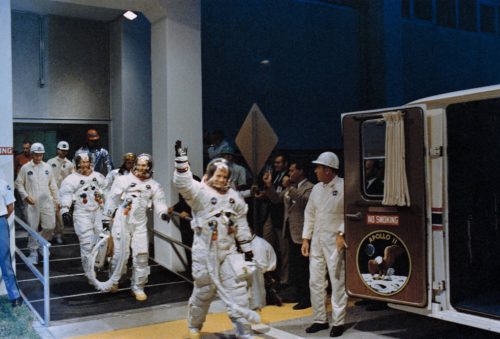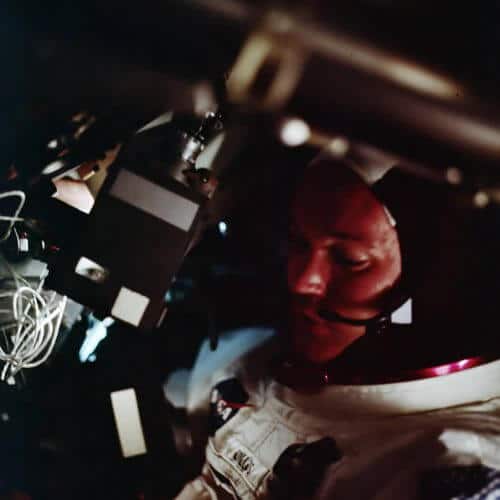The countdown, the launch and the maneuvers that followed, including the disconnection from the third stage of the launcher and the connection to the lunar lander went smoothly. Part one of two.

50th anniversary of Apollo 11: The journey to the moon begins
About a million people gathered on the beaches of central Florida to witness the launch of Apollo 11, while more than 500 million people around the world watched the event live on television. Michael Collins was ready to carry out the historic mission, when only six months earlier, astronauts had tried the Apollo spacecraft in orbit around the Earth and only two months earlier, Apollo 10 had completed the return flight reaching the moon but not landing. Now it's time to try the landing itself.
Launch day, on July 16, 1969, began for the astronauts with a 39:XNUMX a.m. wake-up call from Astronaut Office Director Donald Donald Slayton. After the traditional pre-flight breakfast - a buffet meal, the astronauts put on their suits and traveled in the Astro-Van to the Kennedy Space Center's XNUMXA launcher.
White Room workers helped them into their seats in the Columbia Command Module that sits atop the giant Saturn 5 launcher. Armstrong sat in the left armchair, Collins on the right, and finally Aldrin in the middle. After launch center workers closed the hatch to the capsule, the astronauts entered the final two hours of the countdown without issue. As Armstrong noted before takeoff, "it was a smooth countdown."
At exactly 9:32 a.m., Apollo 11 lifted off to begin mankind's first attempt to land on the moon. The engineers in the launch room, who managed the countdown, transferred control of the spacecraft to the mission control room at the Manned Space Flight Center, (later renamed the Johnson Space Center in Houston) as soon as the launcher left the launch pad. The command was taken by the green team in Houston. The astronaut who spoke directly to the crew from the control center was Bruce McCandless.
The three Saturn 5 stages successfully put Apollo 11 into low Earth orbit. For the next two and a half hours, with the Apollo spacecraft still attached to the third stage of the Saturn launcher, the astronauts and the control center verified that all systems were functioning properly. McCandless called to the crew, “Apollo 11, you're going into orbit beyond the moon, and then the second ignition of the third stage engine that accelerated them toward the moon.
As mentioned two hours and 44 minutes after the launch, the third stage was ignited for six minutes and increased their speed to over 38 thousand km/h, enough to escape the Earth's gravity. Armstrong told the control room after firing the stage on Tuesday that "Stron gave us a great boost." It was beautiful.” A little more than three hours after launch, and at an altitude of about 5,000 km above the Earth, the Columbia command and service module separated from the third stage and began rollover maneuvers to extract the lunar landing module that was still attached to the launcher. He instructed Columbia to dock with the eagle (eagle was translated at the time to eagle, but the exact translation is ait, AB).
Collins flew Columbia about thirty meters and rotated it facing the Eagle and then ejected it from the third stage and disengaged again as the third stage left Earth's orbit and began orbiting the Sun. During the maneuver, the spacecraft moved another 5,000 km away from Earth.

Everything went smoothly
During the remainder of Apollo 11's first day in space, a control center reported to the crew that because the launch and thrust toward the moon had been so precise, there would be no need to correct the planned course midway. In the control room the white team took over, headed by astronaut Charles Duke. The astronauts were surprised by a 16-minute color TV broadcast, providing viewers on Earth with spectacular images of their planet. They then began spinning the spacecraft in a passive temperature control mode or in popular words barbecue mode, with the spacecraft rotating around an axis three times an hour to dissipate the heat due to the extreme difference between the side facing the sun and the other. Finally, about 13 hours after launch, and a long day, the crew began their first period of sleep, when Apollo 11 was more than a hundred thousand kilometers above the Earth.
During the night, the black crew led by Glyn Looney took over control and astronaut Ronald Evans in command, who checked all the spacecraft's systems. When the astronauts woke up, 177 km away, the green team took over again. Astronaut McCandll provided the crew with an update on the morning's news, including the status of the Russian Luna 15 spacecraft that was launched three days before Apollo and is still on its way to the moon. By the time Apollo 11 reached the halfway point between the Earth and the Moon, the following conversation was lost between Apollo 11 Backup Team Commander James Lovell in the cold center and Armetsrong aboard Columbia:
Lovell: Is the commander found? Here is Jim Lovell calling Apollo 11
Armstrong: "Here is the commander"
Lovell: I was a little worried, I'm still on standby as the backup commander, you still haven't told me are you flying?
Armstrong: You lost your chance to take that spaceship Jim.
Lovell: Okay. I agree.
The crew made the only minor repair on the way to the moon, a three-second burn of the spacecraft's engine to lower the closest point to the moon from 320 km to 111 km. McCandless informed the astronauts that Luna 15 had entered lunar orbit, but its mission was still unclear.
The second part will be published later today
To the article on the NASA website
More of the topic in Hayadan:
